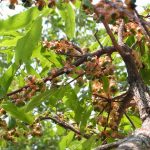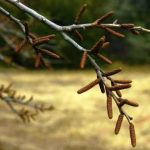TREE LIFE
December 1983
MASHONALAND CALENDAR
Tuesday Decmber 6th : Botanic Garden Walk. Meet in the Car Park at 1645 for 1700 hours.
Sunday December 18th : Meg Coates Palgrave has this year very kindly invited the members and friends to view her plot, Craig Hill, covered in trees both naturally occurring and planted. From 1000 hours onwards. Tea and coffee will be available all day, so come when you please and leave when you like. Please bring a picnic lunch.
MATABELELAND CALENDAR
Sunday December 4th : The AGM of the Matabeleland Branch will be held at 6 Caithness Road, Hillside at 1600 hours. Should the weather be suitable you are invited to bring your costumes to have a swim either before or after the meeting. Tea will be served.
CHEGUTU BRANCH
The good news is that the Chegutu Banch has taken off and will be holding regular meetings/outings on the first Sunday of each month. So –
Sunday December 4th : Black Adder dam. Bring a picnic lunch. Harare members very welcome
BOTANIC GARDEN WALK, NOVEMBER 1ST 1983
As I was overheating with my frogs in the heat of Kariba I am indebted to Kim Damstra for taking notes and revising the walk. Tom Muller deviated from families to look at the numerous trees in flower at this time of the year, an interesting study which I would like to rearrange to illustrate the principles of dicotyledon taxonomy. The system which is still widely used was originally developed by Engler and Pratt and is followed in Coates Palgrave. This arrangement begins with all the plants that lack petals. A strange way to start as these are often highly specialized trees with a complex reproduction. The two figs we examined, the riverine Ficus verruculosa and Ficus bubu from the Haroni-Rusitu valley were actually in flower and not in fruit, a somewhat confusing situation without an understanding of fig biology. All the flowers are encased in the structure as we know as a fig. All figs have a small hole at the far end into which the small female pollinating wasp crawls, bringing pollen from the fig she just left. Not only does she fertilize the receptive female flowers, she also lays eggs within some of the many ovaries, not too many though, because then the tree would abort the fruit, killing her offspring as well. When the eggs hatch the female wasps are fertilized by the males and crawl out of the little hole that their mother crawled in. On the way they pass the male flowers which by this time have ripe pollen to be taken to the next fig. An intricate process with numerous ramifications I do not propose to discuss here, I just wish to illustrate the complexity of this petal-less flower.
Instead of putting the flowers without petals first some arrangements consider the ANNONACEAE to be among the simplest of flowers. We examined the liver coloured flowers of Monodora junodii. Juno represents the essence of female sexuality and this is a plant that deserves cultivation for its seductive fascination. The flower has three sepals and six petals, an interesting start as most dicotyledons are in whorls of four or five. The three inner petals arch over, almost enclosing the numerous squat anthers and free ovaries all arranged in a tight spiral. Both the spiral arrangement as well as the numerous ovaries, each a chamber totally separated from all the others (compare with the tomato where the chambers share common walls) are considered simple characteristics. This arrangement is very similar to that found in the palms, ARECACEAE, where the flower is also arranged in threes. Some would arrange the ANNONACEAE between the palms and other dicotyledons as well as putting the palms at the beginning of the monocotyledons. The Artabotrys brachypetalus flower also showed these features although the fascination still lies in the strangely hooked peduncle or flower stalk that helps this plant to climb by continuing to grow even after the fruit is shed. Plants are arranged in an order of greater fusion. The caper family CAPPARACEAE are one step further than the ANNONACEAE, the ovaries are no longer separate but fused together into one structure. Cladosteman kirkii is indeed a flowering tree of great beauty. Between the two small and two large petals a long androgynophore protrudes. This consists of the stamens fused to form a gutter which tightly grips the pistil. Walking past Maranthes goetzeniana we noticed the interesting fruit similar to Paranari. These both belong to the family CHRYSOBALANACEAE which was once part of the ROSACEAE, which includes the apple and pear. In this area the fruit is often formed not by the swollen ovary as in most other families but the region underneath the superior ovary, called the receptacle, expands after fertilization to envelop the ovary and then swells forming the flesh. In an apple the original ovary is only the apple core! Maranthes is a 40 – 55m forest tree of the eastern mountains. The three legume families are considered especially closely related to the CHRYSOBALANACEAE. The legumes are tied together by their distinctive seed pod and so within this group we start again with the flowers with reduced petals, the MIMOSACEAE. We saw the shaving brush flowers of Albizia which are formed by numerous stamens. In A. gummifera the inflorescence has a central star-shaped flower without stamens surrounded by numerous bundles of pink stamens fused to form a tube from which the style emerges. A. schimperiana lacks the central star and has white stamens. This colour difference allowed easy identification of A. gummifera while looking down on Vumba gulley forests recently. Here both species grow alongside one another. Back in the gardens A. versicolor displayed its large cream flowers. In contrast we examined the closely related germs Acacia as A. nigrescens displayed its spike of white anthers. In the Cassia family CAESALPINIACEAE we saw the yellow flowers of Erythrophleum suaveolens, the ordeal tree of the Haroni-Rusitu valley. The flowers were too high to examine closely but we have seen many of the Cassia type flowers recently. PAPILIONACEAE are the typical pea flowers of the school syllabus. We looked at the white Dalbergia melanoxylon and violet Lonchocarpus capassa. Lonchocarpus is in full flower along the Makuti Kariba road at present, although the flowers blend into the grey leaves. None of these seem to be infested with the bug that sucks the sap to excess causing ‘rain’ underneath the branches although this phenomenon is very conspicuous at the moment in the avenues of Tipuana in Harare. These large yellow flowering exotics form a canopy over the road and ‘rain’ down so profusely there are well developed puddles beneath their boughs. Certainly a feature I had not been aware of before was the fact that the BURSERACEAE are supposed to have separate sexes. At Saffron Walden last month I remember examining the four tall and four short anthers on a fruiting C. africana, later in the day we dissected out a similar arrangement in C. marlothii on the kopje.
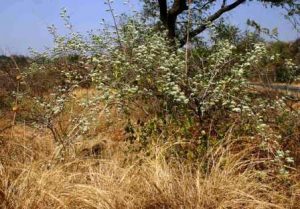
Combretum mossambicense. Photo: Bart Wursten. Source: Flora of Zimbabwe
The COMBRETACEAE petals are still separated from one another, although the receptacle has fused over the ovary resulting in an inferior ovary. We examined the sweetly scented C. mossambicense. Two weeks later this specimen was covered in pink velvety 5 winged fruit.
By the time we get to the APOCYNACEAE the petals are fused and we are back to the superior ovary. This family was extensively discussed last month so it was interesting to examine the flowers on Tabernaemontana ventricosa, the smaller flowers of T. elegans, the long petals of Strophanthus kombe, the scented Wrightia natalensis and the often unpaired fruit of Rauvolfia. I was interested to see the finely branched Carissa bispinosa var. acuminata in flower. This plant is common in the Bunga forest where I hotly denied it was this species as it differs so greatly from the robust var. bispinosa of the Cape.
The opposite decussate branches of the compound Rhizogum zambesiacum, BIGNONIACEAE, of Chipinda Pools is one of the three day wonders of the flowering trees. The yellow flowers have a rich scent. Just in comparison we examined R. brevispinosa of Matabeleland with its simple fascicled leaves.
In the RUBIACEAE the fused petals are combined with an inferior ovary. At the botanic garden walk Tom showed off his magnificently flowering Gardenia resiniflua while I had only just discovered this incredible plant in the foothills of the Kariba escarpment that morning. Although not in flower at Kariba the profusion of yellow resin from the buds was very noticeable. It is not know whether this resin which is similar to that we saw last month in the toad trees serves to lubricate the expanding bud, protect the bud against insects, some resins are high in tannin, or encourage certain micro organisms.
To round off the walk we also examined the small scented tubes of Cremaspora, yet another of the enormous number of confusing RUBIACEAE of the eastern highlands.
-Kim ST.J.Damstra
OUTING TO AUK’S NEST FARM, BEATRICE, 20TH NOVEMBER 1983
This month Harare members were the guests of John and Judy Conolly at Auk’s Nest Farm on the Harare side of Beatrice. We were very pleased to have with us on this occasion Gilbert Green of the U.K., tree conservation organization The Men of the Trees. On arrival we were welcomed to a delightful tea with scones and snacks laid on by Judy and her three lovely daughters. We then piled onto the bus again and proceeded through the tobacco fields to a relatively undisturbed area of bush bordering on a boulder strewn vlei and stream.
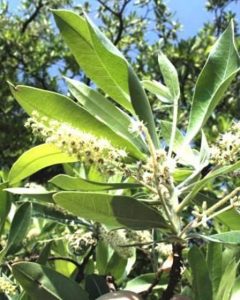
Terminalia sericea. Photo: Mark Hyde. Source: Flora of Zimbabwe
The first tree to attract our attention was Terminalia sericea which was in flower. The flowers were rather attractive spikes of creamy yellow about three inches in length. We do not, in fact, see these often. The whole area was permeated by the cloying scent which despite its superficial sweetness has a nauseating undertone. Nearby was Burkea africana with the remnants of tassels of flowers and in new fresh green leaf. The russet velvety growing tips were still quite obvious and served to identify it immediately. Also with the remains of flowers was Swartzia madagascariensis, the snake bean tree. Unfortunately the flowers had lost the single white petal which makes the tree so distinctive, but the tree’s identity was confirmed by a single snake bean pod from last season. Next to it was a Lannea discolor in new leaf showing the pale underside to the leaf which accounts for the specific name. It was exciting to note that the leaflets were drooping down so that the opposite leaflets were hanging “back to back”; presumably a device to reduce transpiration on such a hot day.
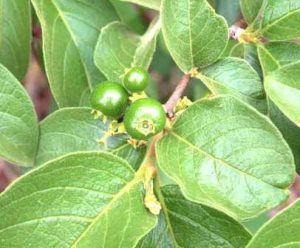
Vangueria infausta. Photo: Rob Burrett. Source: Flora of Zimbabwe
Moving on into an anthill thicket we saw a smallish Kirkia acuminata with its distinctive delicate leaflets. This was not unfortunately, in flower. Here we also saw an Ochra pulchra with typical peeling bark revealing the pale smooth under bark. Later we were also able to compare the small leafed O. puberula, which has quite different grey bark which does not peel. In this area also were Gardenia volkensii and Vangueria infausta both members of family RUBIACEAE and having the trade mark of interpetiolar stipules. Diospyros lycioides was here in profusion in flower and we also saw Grewia flavescens which has rather unusual square stems.
Higher up in the rocks there was, I believe, a truly enormous Vitex payos, the chocolate berry, which was flowering to the delight of those that saw it. The small flowers have two blue petals and three white petals and give off a pleasant scent. Something else I personally missed but which I gather was a decent sized tree was Maerua triphylla with trifoliate leaves and a long petiole.
Moving our across the vlei area towards the rocks near the stream we encountered both Acacia karroo and A. sieberiana both of which have straight thorns. A. karroo does tend to get long white thorns, even on the new branchlets. Both get round baubles of flowers. A. sieberiana gets creamy white flowers which those of A. karroo are bright yellow. The tree shape is very different. A. sieberiana often having a real flat top appearance and A. karroo being rounder in shape with branchlets striking out so it looks like an umkempt “Mufushwa” hairstyle. The young branchlets on A. karroo tend to have a rusty red colour which is also seen in A. rehmanniana. However close inspection of this latter tree, which we saw in the afternoon, shows what are probably the tiniest of leaflets on any of our trees, sometimes as small as 1 x 0.5mm. This also gets round white flowers like A. sieberiana, but again the small size of the leaflets will distinguish it from the latter.
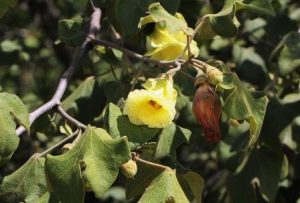
Azanza garckeana. Photo: Bart Wursten. Source: Flora of Zimbabwe
Coming back into a rocky area we encountered an Azanza garckeana and noted the gland on the midrib on the back of the leaf. There was a medium sized Ficus thonningii nearby whose own aerial roots were busy “strangling”itself. The resultant entanglement of roots was a fascinating sight. In this area we also saw Commiphora africana, Elephantorrhiza goetzei and some Boscia salicifolia in green fruit. The leaves on this latter tree are long and thin which explains the specific name meaning “leaves like a willow”. On the underside of the leaf the midrib is very prominent and is a contrasting pale yellow colour.
We then passed some rock paintings, one of which showed a pretty clear rhino. Another in the shape of a circle shaded on one side is thought to depict the new moon, which must be pretty unusual.
Moving on we passed a Ficus verruculosa resting on and partially covering a low rock like a toupee. Usually this is a ankle high ground creeper but this one was quite substantial with a thick trunk. Lots of ants were being attracted to the ripe fruit.
On a high anthill in amongst the rocks was an enormous tree which had us all guessing for a while. Closer inspection showed it to be Schotia brachypetala which is a common constituent of anthill vegetation. Later in the day we were able to examine rachis on the leaf. We also saw the seed pods, the sides of which peel away leaving a rim to which the seeds, partly enclosed in a yellow aril, are attached.
Along the banks of the dry stream were a number of Syzygiums. There was discussion as to whether these were S. guineense or S. cordatum as they were not entirely sessile, i.e. without petioles. The general feeling was that they could well have been hybrids. An interesting comparison was S. huillense, a dwarf Syzygium occurring in the vlei. While not a tree, this little evergreen “sub shrub” has a very similar flowers and leaf arrangement in opposite pairs as in “big brother”.
Before leaving off the mornings walk I should mention that we did see at different places both Ximenia caffra and X. americana, the former in green fruit and the latter in ripe orange fruit. X. caffra has green or green yellow foliage while X. americana has more blue green leaves which are generally glabrous.
On our way back for lunch we saw from the bus a single Kigelia africana, sausage tree, which was past flowering but not yet fruiting. Due to some ancient injury the tree had a large hole straight through the trunk which was largely hollowed out.
After lunch on the lush green kukuyu grass at the house, those whose energy had not already been exhausted jumped into the bus heading for the many anthills dotted about the tobacco lands. We saw Schotia again next to a Ficus thonningii. Here were large quantities of Carissa edulis in fruit, so the gastronomists amongst us had a tasty dessert. We also saw Euclea divinorum, Allophylus africana and Clerodendrum glabrum with its strange scented leaves. Sadly we were too late, or early, for the flowers.
Much heated discussion was caused by a Combretum with large fruit. The fruit seemed to be intermediate in size between C. collinun and C. zeyheri so no one was sure either way. Another hybrid perchance?
Walking along an ancient iron-working excavation we came across numbers of Peltophorum africanum, supposedly associated with old workings. We also came across Cassine aethiopica and to the delight of all found a Dichrostachys cinerea with a few pink and yellow flowers and also some characteristic Medusa head pods.
In a lower lying area we saw Combretum hereroense, the mouse eared Combretum and while one tree had distinctly furry leaves, another, not more than 100m away had quite glabrous leaves. We also saw the very rough-leafed Ficus sycomorus resplendent with fever yellow bark and apple green leaves.
A most enjoyable and interesting day was had by all, and to John and Judy we extend our hearty thanks.
-J.P.Haxen
MATABELELAND NOTES
November outing : Four of us went to Somerset for a recce. The valley is very hot, dry and the trees are exclusively Acacia of no great variety. If one climbs out of it though the vegetation becomes much more varied and it is above the valley that we find the Securidaca longepedunculata. On this occasion they must have been at the height of their flowering, a dozen or so very large trees completely covered in bloom. We sat under the shade of a Parinari curatellifolia to cool off after our climb and were engulfed in the scent of the flowers. When we returned to the car we looked up the slope through our binoculars and could see the violet of the trees among the surrounding vegetation.
However, we considered that the rough strenuous climb would be to the liking of most of the members so we decided to change the venue to Lionel Reynold’s property on Golden Gate Road. Lionel has about thirty acres and has identified a hundred and ten different species. Unfortunately the outing was somewhat of a fiasco, it was a hot day, there was hardly a leaf to be seen anywhere and after less than an hour the members decided they had had enough of trying to identify mere twigs and made for the shady lawn and tea. There has been a little rain since then so we hope that our next outing will prove to be more satisfactory.
CHEGUTU NOTES :
It is indeed a pleasure to announce the arrival of a budding new branch of the Tree Society in Chegutu. There has been much enthusiasm in the area for quite a while, this has now been catalyzed by Mr. Charles Wolstenholm of Kufara Farm. We are indeed grateful to Dick Petheram, a knowledgeable past chairman of the society and patient teacher, both for being present as well as writing up some interesting notes.
An interesting find, within a few metres of the security fence surrounding Kufara homestead was Uapaca nitida in fruit, within a few weeks of ripening. The big “mahobohobo” or “Muzhanje”, U. kirkiana, also occurs in the area, but the smaller leafed and smaller fruited U. nitida was not recorded during the Tree Society visits to other farms in the district. An unusually profusely leafed Dalbergia melanoxylon was found. At this time of the year a lot of deciduous trees are in new leaf and identification can be difficult, especially in the failing light on Saturday evening. One such was Olax dissitiflora a cutting of which, when subsequently pressed, was found to have some fresh flowers as well.
The following morning was spent examining trees in the immediate vicinity of Kufara homestead. Fruiting specimens were found of Lannea discolor, Uapaca kirkiana, Pseudolachnostylis maprouneifolia, later seen in flower, the rubber tree Diplorhynchus condylocarpon, musasa Brachystegia spiciformis and munondo, Julbernardia globiflora. A young Ficus thonningii was beginning to show its strangler propensities on one of the trees.
The afternoon walk on the neighbouring farm, Lourie, was notable mainly for the mass of Euphorbia matabelensis on the kopje, competing for pride of numbers with Commiphora mossambicensis. There were two spectacularly peeling Albizia tanganyicensis trees growing in the immediate vicinity of an Albizia antunesiana. A large number of Lannea discolor trees with leaflets so young and fresh that they were clasped together for protection in the heat, presented the most notable feature. The climax of the walk was the sight of a very fine specimen of Ficus abutilifolia in full leaf and some fruit, its strong white roots splayed out on a granite boulder, a large chunk of which was uplifted and held by the roots more than a foot above the base.
Another memorable find was a quantity of ripe fruit from the Strychnos innocua, monkey orange, of which we saw a particularly good specimen on Kufara. This fruit is very much sweeter than the larger fruits of S. cocculoides and S. spinosa and Steven Mavi of the Herbarium says he prefers it to any other Strychnos fruit. We found it markedly sweeter and without the tang of the others.
In interesting proximity to each other, on the return journey to Kufara were Maerua angolensis in full “necklace pod” and the contrasting shrubby Maerua juncea subsp. juncea, also in fruit, round large marble size. Vegetatively, the two bear so little resemblance to each other that it is difficult to credit that they are so closely related.
About 60 species of trees and shrubs were recorded in a relatively short time. In the limited area we covered there were no Acacias, which we know to be plentiful in the district. A wider ranging expedition will doubtless reveal them and several other genera we expected to find.
R.W.Petheram
ROOT NOTES : Our treasurer, Brian Best’s rummaging in the herbarium has unearthed the information that the tree nettle, Urere tenax,is now in a new genus and has become Obetia tenax (N.E.Brown) Friis.
Please note that the subscriptions have been increase to $5.00 single and $6.00 family membership. In view of our financial situation I would urge you to forward this modest amount as soon as possible.
Recently, sadly, Doug and Lola Irvine left Zimbabwe to do some globe trotting before deciding on their long term plans. Doug eventually retired as G.M. of the E.S.C. to which he had given many years service. From our point of view Doug and Lola were members of long standing, Doug having served as a committee member and then Chairman in 1971. Lola also served on the committee until the end of last year. Both were “pillars” of the Society and a fund of knowledge, ever eager to share it with beginners and fundis alike. We wish them all the best of luck and happiness wherever they may go and hope that it’s not good-bye but au revoir.
-Phillip Haxen, Chairman


